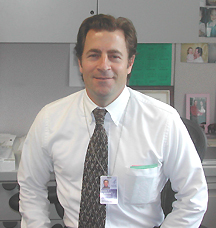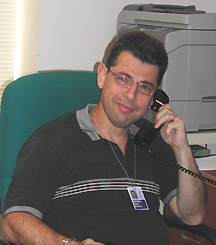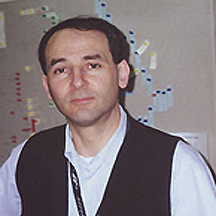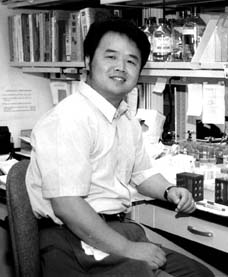
| T H E N I H C A T A L Y S T | S E P T E M B E R – O C T O B E R 2004 |
|
|
|
| P E O P L E |
RECENTLY TENURED
 |
|
Mark
Gladwin
|
Mark Gladwin received his M.D. from the University of Miami Honors Program in Medical Education in 1991. After completing his internship and chief residency at the Oregon Health Sciences University in Portland, Ore., he joined the NIH in 1995 as a critical care fellow in the Clinical Center. After a one-year clinical fellowship in pulmonary medicine at the University of Washington in Seattle, he returned for a research fellowship at the Critical Care Medicine Department, CC, under the mentorship of James Shelhamer, Frederick Ognibene, Alan Schechter, and Richard Cannon. He is currently head of the Vascular Therapeutics Section, a new section within the Cardiovascular Branch, NHLBI.
The clinical research activities of the Vascular Therapeutics Section are linked to the CC Critical Care Medicine Department. This collaborative effort intends to develop a new scientific research program focused on four major lines of research, each containing a strong and smooth interaction between bench and bedside investigations.
The first major area of my section’s investigation focuses on the biochemistry of nitric oxide (NO), nitrite, and hemoglobin in blood and the role of such chemistry in physiology and pathophysiology. These studies span basic chemistry and development of methods, biomarkers for endothelial function, and clinical protocols for nitrite and NO therapeutics.
A second major area of research evaluates endothelial dysfunction in sickle cell disease. This includes basic studies of the dysregulation of NO-dependent blood flow and NO bioavailability in sickle cell disease and extends to clinical trials of pharmacotherapy for endothelial dysfunction in affected patients.
The third area of active research explores the emerging syndrome of hemolysis-associated pulmonary hypertension common to sickle cell disease, thalassemia, and most chronic hereditary or acquired hemolytic anemias. These investigations will evaluate the role of NO scavenging by plasma hemoglobin in the development of endothelial dysfunction, adhesion molecule upregulation, endothelial permeability, and oxidant stress.
A final area of active investigation covers global transcriptional analysis in human vasculopathy, with the focused development of assays to amplify key expressed genes in target tissues (endothelial cells, platelets, and monocytes) in patients with sickle cell anemia, pulmonary hypertension, and endothelial dysfunction syndromes. We are also evaluating the protective effects of the heme-oxygenase system and heme-induced catalytic antioxidant systems in these diseases.
Over the past six years, our research in these areas has led to four important scientific discoveries, 56 published manuscripts, 18 pending or approved protocols, and 462 patient enrollments.
The four scientific discoveries are
![]() The characterization of a novel mechanism-of-disease paradigm, namely, hemolysis-associated
endothelial dysfunction (Reiter, et al. Nature 2003)
The characterization of a novel mechanism-of-disease paradigm, namely, hemolysis-associated
endothelial dysfunction (Reiter, et al. Nature 2003)
![]() The mechanistic, clinical, and epidemiological description of a human disease
syndrome, namely, hemolysis-associated pulmonary hypertension (Gladwin,
et al. NEJM 2004)
The mechanistic, clinical, and epidemiological description of a human disease
syndrome, namely, hemolysis-associated pulmonary hypertension (Gladwin,
et al. NEJM 2004)
![]() The discovery that the nitrite anion is a circulating storage pool for NO (Gladwin,
et al. PNAS 2002)
The discovery that the nitrite anion is a circulating storage pool for NO (Gladwin,
et al. PNAS 2002)
![]() The discovery of a novel physiological function for hemoglobin as an electronically
and allosterically regulated nitrite reductase (Cosby,
et al. Nature Medicine 2003)
The discovery of a novel physiological function for hemoglobin as an electronically
and allosterically regulated nitrite reductase (Cosby,
et al. Nature Medicine 2003)
 |
|
Markus
Heilig
|
Markus Heilig received his M.D. and Ph.D. in psychiatry from Lund University, Sweden, in 1986 and 1989, respectively. After completing postdoctoral research at Scripps Research Institute in La Jolla, Calif., and a clinical fellowship at Göteborg University in Sweden, he became director of the addiction medicine department at the Karolinska Institute in Stockholm. He was chief of research and development in the psychiatry division of the Clinical Neurosciences Department at Karolinska before joining NIAAA in 2004. He is chief of the Laboratory of Clinical Studies and clinical director of the Division of Intramural Clinical and Biological Research, NIAAA.
One day you have life all worked out, from who’s picking up what kid where, to automatic notification when a postdoc posts a revised paper on the server. One flight later, nothing is in place, and you can’t get a phone without a $500 deposit. I’ve moved before, but, oh, is it different to pack up the life of a single postdoc vs handling the transition for a family of six and a research group of 10.
So at 4 in the morning I have to remind myself why. Because the U.S. makes an investment in biomedical research that on an average gives a group in the neurosciences sevenfold larger resources than a comparable group at the Karolinska, my former research home. Because the NIH community therefore has become an environment to be admired by all the Karolinskas and Cambridges of the world. And because the alcohol institute is in the process of developing an agenda combining great science with clinical relevance, which appeals to me as a clinician.
What got me tenured? They don’t tell you, do they? And I find it embarrassing to boast any accomplishments. My interest is in motivation and emotion, nowadays primarily as they relate to alcohol and drug abuse. I’m a clinical psychiatrist, saw the last patient three weeks ago [mid-July], and still coordinate a government-sponsored clinical trial for pharmacological treatment of heroin addiction in Sweden.
But for the last 15 years, I’ve also used preclinical models to identify potential new treatment targets for addiction, anxiety, and depression. Like most, I started out testing my own favorite candidates. So if you want to discuss neuropeptide systems like NPY, CRF, and tachykinins, stop by and let’s have a cup of coffee.
But recently, we’ve gone to the more humbling open-ended strategies, to discover targets we wouldn’t have been able to hypothesize. We model the course of neuroadaptive processes in the brain as it undergoes repeated cycles of alcohol intoxication and withdrawal, and we use DNA arrays to identify new targets. So far, the list of hits includes cannabinoid receptors and several signaling pathways that seem quite promising. We’ve been fortunate enough to join a core array facility between NHGRI, NINDS, NIMH, and now NIAAA (thank you, Eric Green of NHGRI for working it out). So if you’re interested in that as a strategy, or any of those targets, come by for a second cup.
But of course it doesn’t stop there. If it did, I could be at any well-funded pharmacology department. The unique potential of the intramural program, and the NIAAA Laboratory of Clinical Studies in our case, is to take whatever comes out from the rat and mouse models and go on. Where else could I speak to a world-class primatologist, Dee Higley, and do studies that model craving and decision-making in ways that are just too complex for rodents? Where else discuss with a first-class imaging expert, Dan Hommer, how to find the regional brain metabolism "signature" of the relevant clinical states and see how clinically effective drugs modify it? And finally and most importantly, where else take whatever looks interesting after this set of translational filters, and actually test it for clinical efficacy, in-house?
Maybe it is this kind of integrative capacity, from molecule to patient, rather than a specific paper the tenure committee liked? I’d like to think of it that way. And once I figure out how to get that phone, and how to fill out all the forms (23 at present count), I’ll start enjoying the fantastic opportunities of this great place. If we don’t come up with some clinically useful treatments within the next five years, I’ll have no excuses.
 |
|
Konrad
Noben-Trauth
|
Konrad Noben-Trauth obtained his diploma in Biology from University of Heidelberg in Germany in 1990. He was awarded a Ph.D. in Molecular Biology from University of Freiburg in Germany in 1994. In his thesis he studied the murine myb gene family of transcription factors in the laboratory of Karl-Heinz Klempnauer at the Max-Planck-Institute for Immunobiology in Freiburg. He performed postdoctoral studies at The Jackson Laboratory, Bar Harbor, Me., in the lab of Patsy Nishina and Jurgen Naggert from 1994–1997, investigating the genetics of sensorineural defects in mice. He joined NIDCD in 1997 and currently heads the Section on Neurogenetics.
Hearing is the perception, transmission, and interpretation of acoustic stimuli. It is a multistep process that involves the mechanical deflection of stereocilia hair bundles on sensory hair cells in the organ of Corti, opening of mechanically gated transducer channels, and transmission of the electrical stimuli to the eighth cranial nerve for further processing in the central nervous system.
My lab is interested in the molecular factors and mechanisms that underlie the initial steps of this pathway. We apply a positional cloning strategy, using classical mouse deafness mutants (deafwaddler, waltzer, varitint-waddler, Jackson circler) and common inbred strains (C57BL/6J, DBA/2J), that segregates monogenic and polygenic sensorineural hearing loss. This forward genetic approach is ideal for dissecting molecular pathways in the organ of Corti because there are many mouse mutations with defects in the cochlea. In addition, deaf mice often replicate human hereditary hearing loss and thus can be used to study the cellular and molecular underpinnings of human deafness.
The varitint-waddler (Va) mouse carries a semi-dominant mutation causing early-onset hearing loss, vestibular defects, pigmentation abnormalities, and perinatal lethality. Hearing loss is preceded by the disruption of the organizational structure of the stereocilia hair bundle during late embryonic development, subsequently leading to hair cell degeneration.
We identified two new members of the Mucolipin gene family in the critical interval and identified causative missense mutations in Mucolipin-3 (Mcoln3). Mcoln3 encodes a TRP ion channel, which localizes to vesicles and the plasma membrane of stereocilia, leading us to hypothesize that Mucolipin 3 is involved in mechanotransduction.
Deafwaddler (dfw) is a recessive mutation that leads to congenital deafness and locomotor abnormalities. In collaboration with Bruce Tempel (University of Washington in Seattle), we showed that the plasma membrane calcium pump PMCA2 (Atp2b2) is essential for balancing Ca2+ levels in stereocilia. Ca2+ plays an important role during the fast and slow adaptation process of the mechano-transduction complex.
Our work on the deafwaddler mutation showed that its recessive inheritance is tightly controlled and mod-ified by the genetic background: On the CAST/Ei strain, heterozygotes exhibit a normal phenotype, whereas on the BALB/cByJ background, +/dfw mice are deaf. We mapped this modifier locus (mdfw) close to the waltzer mutation.
Waltzer mice show erratic circling behavior and are deaf from birth. We cloned a new type of cadherin, cadherin 23, encoding a 3,354–amino-acid single-pass transmembrane protein with 27 extracellular cadherin domains. Based upon its predicted function and the disorganized stereocilia bundle in waltzer mutants, we proposed cadherin 23 as a component of the inter stereocilia links that structure the hair bundle and connect the individual stereocilia.
In collaboration with Christian Kubisch, University of Bonn in Germany, we also demonstrated that the human homolog, CDH23, underlies Usher syndrome type 1D, a recessive disorder characterized by deafness, blindness, and vestibular deficits.
Recent work from my lab showed that a functional single-nucleotide polymorphism (SNP) in Cdh23 explains the mdfw modifier effect. The silent single-nucleotide change occurs at the last position in exon 7 of Cdh23 and alters splicing, generating a protein with diminished function.
We also showed a near-perfect correlation between this hypomorphic Cdh23 allele and age-related hearing loss (AHL): Of 31 inbred strains classified with AHL, 27 carry the hypomorphic allele, and of 25 normal-hearing strains, 22 segregate the wildtype variant. We concluded that the polygenic hearing loss observed in many common inbred strains—such as C57BL/6J, 129/Sv, and DBA/2J—is largely caused by this SNP in Cdh23.
We plan to study additional complex inheritance models, especially those found in outbred populations. We are interested in the molecular function of Mcoln3 and Cdh23 and their role in the transduction current and stereocilia maturation. We plan to expand our genetic studies into human populations with emphasis on the susceptibility to noise-induced hearing loss. In the more distant future, we hope to use some of the hearing loss strains as models for stem-cell–based therapeutic approaches.
 |
|
Weidong
Wang
|
Weidong Wang received his Ph.D. from the University of California, Los Angeles, in 1991. He performed his postdoctoral training at Stanford University in Stanford, Calif. He has been chief of the Transcription and Remodeling Unit, Laboratory of Genetics, NIA, since his arrival at NIH in 1997.
Multiprotein complexes have been implicated in the regulation or modulation of many cellular processes. Usually, a cellular protein is not present on its own. Instead, it will often be present in several complexes, with each complex performing a unique function. Thus, the biological functions of a given protein can be fully understood only when the consequences of its association in complexes are defined.
Our unit has used a biochemical approach to defining targeted complexes, starting with the development of a highly efficient immunopurification protocol to isolate the endogenous complexes from mammalian nuclear extracts in highly purified form. We have focused on studies of two families of multiprotein complexes involved in gene expression and genome stability, in two corresponding projects:
![]() Project I. Chromatin-remodeling complexes that participate in gene regulation
Project I. Chromatin-remodeling complexes that participate in gene regulation
![]() Project II. Nuclear complexes involved in genome instability syndromes
Project II. Nuclear complexes involved in genome instability syndromes
In the eukaryotic nucleus, the chromatin structures that store genetic information tend to render the DNA inaccessible to metabolizing enzymes. This repressive chromatin structure must be remodeled to allow transcription and other metabolic reactions to occur. Chromatin-remodeling complexes play key roles in the remodeling process, which is critical for multiple cellular functions, including transcription, replication, repair, chromatin assembly, and chromosome condensation. In addition, multiple human diseases, including several types of cancer, are caused by mutations in remodeling complexes; and aging in several lower species can be modulated by alterations in remodeling enzymes.
In Project I, we purified several complexes of the SWI/SNF family, identified and cloned their subunits, and demonstrated that these complexes mediate transcriptional activation for specific gene regulators. We showed that one of these complexes contains a fusion partner for mixed-lineage leukemia (MLL) protein, which is a common target for chromosomal translocation in human acute leukemia. Our work implicates human SWI/SNF complexes in the etiology of leukemia.
In another study, we identified a novel complex, called NURD, and showed that it is involved in repression of gene expression. An unusual feature of this complex is that it contains two seemingly opposite chromatin-remodeling activities. One is removal of a chemical modification of chromatin. This action is often involved in gene repression. NURD’s other activity is energy-dependent chromatin disruption, which, at the time of our study, was associated only with gene activation. But our data suggest that energy-dependent chromatin disruption can also participate in gene repression by helping repressors to gain access to their targets in chromatin.
We recently identified a complex involved in human ATR-X syndrome. Patients with ATR-X syndrome have severe mental retardation and a-thalassemia (lower level of a-globin in blood). We demonstrated that the defective protein defective in this disease forms a new chromatin-remodeling complex with a regulator of gene expression. Defects in this disease may thus result from inappropriate expression of genes controlled by this complex.
In Project II, we purified several multiprotein complexes involved in human genomic instability diseases, including Fanconi anemia, Bloom syndrome, and Rothmund-Thomson syndrome. Among them, the purification of the Fanconi anemia core complex has led to novel insights into the disease mechanism, including the discovery of four new genes, whose mutations may cause Fanconi anemia (we have confirmed two of these and are accumulating evidence for the other two).
Recessively inherited, Fanconi anemia can include congenital defects, bone marrow failure, genomic instability, and cancer susceptibility. Patients have been classified into 11 complementation groups, with each group carrying genetic mutations in the same gene.
Recently, studies of this rare disease have attracted widespread attention because one of the Fanconi genes, FANCD1, has been shown to be identical to the breast cancer susceptibility gene BRCA2. It is now believed that Fanconi and breast cancer proteins may function in the same pathway during DNA damage response. However, the mechanism underlying this pathway has been poorly understood, because most known Fanconi proteins lack recognizable structure motifs and an identifiable biochemical activity.
We have purified a nine-subunit Fanconi protein complex and found that it contains not only five known Fanconi proteins, but also four other proteins. We demonstrated that two of the new proteins are also Fanconi proteins, and their corresponding genes are mutated in Fanconi patients of two different complementation groups. Our current data suggest that the other two new proteins also have important biological function for this complex, and their genes are candidates as new Fanconi genes.
We also found a structural motif. One of the new Fanconi proteins has a ubiquitin ligase motif and displays this activity in test tubes. Ubiquitin is a small protein molecule that can be covalently linked to other proteins to initiate protein degradation, translocation, and other biological processes.
It is known that one of the Fanconi proteins, FANCD2, is subject to ubiquitination in response to DNA damage, and this ubiquitination reaction is a key step in the Fanconi protein pathway. The underlying ubiquitin ligase for this reaction has been unknown for some time.
We demonstrated that the ubiquitin ligase identified in our study is most likely the ligase for this reaction, because cells derived from a Fanconi patient with mutation in this gene have complete absence of FANCD2 ubiquitination. Moreover, putting this ligase back into the patient’s cells can correct the defective ubiquitination reaction—at least in vitro.
All our work has been
greatly benefited from collaborations with other groups within and outside NIH.
We are continuing these collaborations to uncover new disease genes and to better
understand the mechanisms of transcription and genome maintenance. ![]()